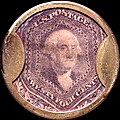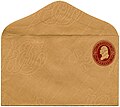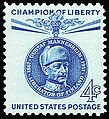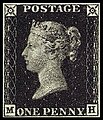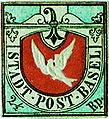Portal:Philately
| Philately portal | WikiProject Philately |
The Philately Portal
Philately is the study of revenue or postage stamps. This includes the design, production, and uses of stamps after they are issued. A postage stamp is evidence of pre-paying a fee for postal services. Postal history is the study of postal systems of the past. It includes the study of rates charged, routes followed, and special handling of letters.
Stamp collecting is the collecting of postage stamps and related objects, such as covers (envelopes, postcards or parcels with stamps affixed). It is one of the world's most popular hobbies, with estimates of the number of collectors ranging up to 20 million in the United States alone.

The Melita issue is a series of dual-purpose postage and revenue stamps issued by the Crown Colony of Malta between 1922 and 1926, depicting the national personification Melita. They were commemorative stamps since they celebrated the islands' new status as a self-governing colony following a new constitution in 1921, but also a definitive issue intended for regular use over an extended period of time.
Designed by two leading Maltese artists, Edward Caruana Dingli and Gianni Vella, the issue consisted of stamps in various denominations from ¼d to £1; Caruana Dingli's designs were used on the pence and pound values and Vella's design on the shilling values. The designs were poorly received when they were issued, and Caruana Dingli himself criticized the execution of the design. In subsequent years, however, Caruana Dingli's design came to be regarded as one of the most iconic Malta stamps, and his design for the figure of Melita formed the basis of the Maltese lira banknotes of 1989–2008 and gold and silver bullion coins minted since 2018. (Full article...)
Selected article -

Monroe Bowers Morton, nicknamed Pink Morton (July 31, 1856 – February 12, 1919) was a prominent building owner, publisher, building contractor, developer, and postmaster in late 19th-century Georgia. An African American, he lived most of his life in Athens, Georgia, where he published a newspaper and built the Morton Building. The building included the Morton Theatre on its upper floors, a vaudeville venue, and offices for African-American professionals including doctors and druggists (pharmacists) on its ground floor. Occupants included Dr. Ida Mae Johnson Hiram, the first Black woman to be licensed to practice medicine (dentistry) in the state, and Dr. William H. Harris, one of the founders of the Georgia State Medical Association of Colored Physicians, Dentists and Druggists. (Full article...)
Selected images
Did you know (auto-generated)

- ... that Amrita Sher-Gil's painting Hill Women appeared on a 1978 Indian postage stamp?
- ... that James Diossa rescued the only public library and post office in Central Falls, Rhode Island, when the city went into bankruptcy?
- ... that both of Karl R. Free's New Deal-era U.S. post office murals with Native American subjects have been challenged as offensive?
- ... that Argentinian Ricardo D. Eliçabe qualified as a physician, co-founded a petroleum refinery, and wrote about forgeries of Bolivia's first stamps?
- ... that after Irish post office clerk Maureen Flavin Sweeney reported worsening weather conditions, Dwight D. Eisenhower agreed to postpone D-Day by 24 hours?
- ... that in 2007, Arthur Gray's £2 Kangaroo and Map stamp sold for a world record price for a single Australian stamp?
General images -
Selected stamp -

The Jamaica 6d abolition of slavery postage stamp was prepared for issue in June 1921 but cancelled shortly before issue due to political unrest and the controversial subject matter.
By some estimates, 416,000 stamps were printed and sent to the island in three shipments. The first two consignments arrived in Jamaica around the same time, and were incinerated at the General Penitentiary in Kingston on July 2, 1921. The final consignment, arriving in October, was similarly destroyed. The Crown Agents were then instructed to destroy the 7220 stamps held in their possession along with about 740 stamps distributed via the Universal Postal Union. Two blocks of four were preserved; one block was given to King George V for his collection, while the other became part of the official collection held at the General Post Office in Kingston. This block mysteriously disappeared from the Post Office's vaults and reappeared sometime later as four singles. (Full article...)
List articles

- List of philatelists
- List of most expensive philatelic items
- List of postage stamps
- Lists of people on postage stamps (article) • (Category page)
- List of entities that have issued postage stamps (A–E)
- List of entities that have issued postage stamps (F–L)
- List of entities that have issued postage stamps (M–Z)
- List of postal services abroad
- Timeline of postal history
Related portals
Topics
Categories
WikiProject
![]() WikiProject Philately organizes the development of articles relating to philately. For those who want to skip ahead to the smaller articles, the WikiProject also maintains a list of articles in need of improvement or that need to be started. There are also many red inked topics that need to be started on the list of philatelic topics page.
WikiProject Philately organizes the development of articles relating to philately. For those who want to skip ahead to the smaller articles, the WikiProject also maintains a list of articles in need of improvement or that need to be started. There are also many red inked topics that need to be started on the list of philatelic topics page.
Selected works
- Williams, Louis N., & Williams, Maurice (1990). Fundamentals of Philately {revised ed.). American Philatelic Society. ISBN 0-9335-8013-4.
{{cite book}}: CS1 maint: multiple names: authors list (link) - Hornung, Otto (1970). The Illustrated Encyclopedia of Stamp Collecting. Hamlyn. ISBN 0-600-01797-4.
- Stuart Rossiter & John Fowler (1991). World History Stamp Atlas (reprint ed.). pub: Black Cat. ISBN 0-7481-0309-0.
Wikimedia
The following Wikimedia Foundation sister projects provide more on this subject:
-
Commons
Free media repository -
Wikibooks
Free textbooks and manuals -
Wikidata
Free knowledge base -
Wikinews
Free-content news -
Wikiquote
Collection of quotations -
Wikisource
Free-content library -
Wikiversity
Free learning tools
Other Portals
Sources
- ^ "Philatelic Collections: General Collections". British Library. 2003-11-30. Archived from the original on 30 June 2011. Retrieved 2011-01-16.




![Image 2Unissued 1956 £1 Jamaican chocolate and violet, the first stamp designed for Queen Elizabeth II. Held in the British Library Crown Agents Collection.[1]](http://upload.wikimedia.org/wikipedia/commons/thumb/9/9b/Stamp_Jamaica_1956_unissued_1sh.jpg/120px-Stamp_Jamaica_1956_unissued_1sh.jpg)





